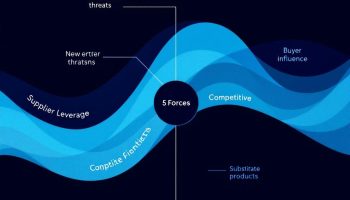
What is Functional Strategic Planning
Functional strategic planning transforms high-level business objectives into specific action plans for each department. This approach creates clear roadmaps for marketing, operations, HR, finance, and IT teams, ensuring every functional area effectively contributes to company goals through initiatives that leverage their unique expertise.
Why Businesses Need Functional Strategic Planning
Functional strategic planning delivers competitive advantages by aligning all organizational parts toward common objectives. In today’s fast-paced business environment, this method optimizes how you allocate resources, builds specialized capabilities, and breaks down departmental silos through coordinated goals.
Your organization becomes more agile and responsive to market changes when departments excel in their areas while staying connected to corporate strategy. Functional planning connects big-picture strategy with day-to-day execution, establishing clear accountability and measurable performance metrics that boost operational efficiency.
This systematic approach helps you convert strategic vision into practical actions at the departmental level, collectively driving your organization toward success. Each functional unit can tackle its unique challenges while maintaining alignment with broader company direction.
Essential Steps for Effective Functional Strategic Planning: 8 Key Areas You Need to Focus On
Functional strategic planning is crucial for translating high-level organizational goals into actionable initiatives within specific departments. This strategic approach ensures that each functional area contributes effectively to overarching company objectives, thereby enhancing performance and competitive advantage. The necessity of aligning departmental strategies with corporate goals cannot be overstated; every function plays a vital role in the business ecosystem. In this section, we will explore eight key areas that are essential for effective functional strategic planning. Each area outlines specific steps and considerations necessary for creating a robust functional strategy that drives organizational success. Whether you’re assessing current capabilities, setting objectives, or establishing governance structures, this guide will provide valuable insights to help your organization achieve its functional planning goals.
I. Introduction to Functional Strategic Planning
Functional strategic planning forms the backbone of organizational execution, translating high-level business objectives into department-specific action plans. Unlike corporate strategy which focuses on overall direction, functional strategic planning addresses how individual departments will contribute to company goals through targeted initiatives. In today’s rapidly evolving business landscape, effective functional planning creates significant competitive advantages by ensuring all organizational parts work harmoniously toward common objectives.
When developing your functional strategy, you’ll need to consider how each department’s specialized expertise can drive overall business performance. Key functional areas typically include:
- Marketing: Customer acquisition and brand positioning strategies
- Operations: Process optimization and supply chain management
- Human Resources: Talent acquisition and development approaches
- Finance: Capital allocation and financial performance management
- Information Technology: Digital transformation and systems integration
Each functional area requires tailored strategic planning approaches that align with its unique challenges while supporting broader organizational goals. By focusing on functional excellence, you create a more agile organization capable of responding to market shifts while maintaining operational continuity.
2. Definition and Purpose of Functional Strategic Planning
Functional strategic planning is a structured approach that focuses on developing strategies for specific departments or functions within an organization to achieve broader business objectives. This planning process ensures that each functional area contributes effectively to the overall success of the company. When you develop functional strategic plans, you create actionable roadmaps that guide departmental activities toward organizational goals.
The primary objectives of functional strategic planning include optimizing resource allocation, developing specialized capabilities, and creating competitive advantages through departmental excellence. By implementing well-crafted strategic planning techniques, you enable each function to maximize its contribution to organizational performance.
Functional strategic planning creates value by:
- Enhancing operational efficiency within departments
- Developing specialized expertise and capabilities
- Reducing functional silos through aligned objectives
- Improving resource utilization and prioritization
- Enabling measurement of functional contributions
Your functional plans must align closely with the organization’s mission and vision to ensure cohesive execution across all levels. Key stakeholders in this process typically include functional leaders, cross-functional team members, and department stakeholders who collaborate to develop plans that support broader strategic initiatives while addressing functional requirements.
Expert Insight: Focus your functional strategic planning on aligning departmental strategies with the organization’s mission to enhance overall performance. Engage key stakeholders in the planning process to reduce silos and optimize resource allocation. This collaborative approach fosters specialized expertise, improving efficiency and ensuring each function contributes effectively to your business objectives.
3. The Strategy Hierarchy in Functional Strategic Planning
Functional strategic planning represents the third level in the organizational strategy hierarchy, following corporate and business-unit strategies. When you develop functional strategies, you’re essentially creating the operational roadmap that implements higher-level directives. This hierarchy ensures that every department’s activities contribute to the organization’s overall mission.
The corporate level determines the company’s vision and scope, while business units define competitive approaches within specific markets. Your functional strategies then detail how individual departments will support these objectives through specialized activities and resource allocation.
Understanding this hierarchical relationship helps you:
- Maintain strategic consistency across all organizational levels
- Establish clear lines of accountability
- Ensure resources are deployed efficiently
- Create measurable performance standards at the functional level
Expert Insight: In functional strategic planning, ensure vertical alignment with corporate goals while fostering horizontal collaboration among departments. Create cross-functional teams, establish shared KPIs, and regularly review strategies to harmonize efforts. This holistic approach enhances both organizational coherence and the efficiency of resource deployment, driving overall success.
4. Key Components of Functional Strategic Planning
Effective functional strategic planning requires several critical components working in harmony. When you develop your functional strategic plans, focus on optimizing how resources are allocated across departments and projects. Your organization’s success depends on strategic resource allocation that maximizes return while minimizing waste.
Capability development represents another crucial element of functional strategic planning. You must identify and nurture core competencies that give your department a competitive advantage. This includes developing specialized skills, processes, and knowledge that support your overall business objectives.
Performance metrics and KPIs provide essential feedback mechanisms in your functional strategic planning process. Establishing measurable indicators helps you track progress and maintain strategic alignment throughout implementation.
Conducting a functional SWOT analysis allows you to identify departmental strengths and weaknesses while revealing external opportunities and threats. This targeted assessment creates a foundation for developing realistic and effective functional strategies.
Cross-functional dependencies require careful consideration during planning. Your functional strategy must account for integration points with other departments to facilitate smooth collaboration across the organization.
Technology and innovation considerations should drive your functional planning process, ensuring your department leverages emerging tools and approaches to maintain competitive advantage in rapidly evolving markets.
Expert Insight: To excel in functional strategic planning, prioritize resource allocation to maximize returns and minimize waste. Focus on developing core competencies and establish clear performance metrics to track progress. Additionally, consider cross-functional dependencies and leverage technology to stay competitive in a rapidly evolving market.
“`html
5. Assessing the Current Functional State
Before diving into functional strategic planning, you must thoroughly evaluate your existing capabilities, processes, and performance. This assessment establishes a critical baseline for identifying gaps and opportunities. Begin with a comprehensive analysis of your functional area’s strengths and weaknesses, examining current resource allocation, team skills, and technological infrastructure.
Consider conducting these assessments:
- Capability maturity evaluations
- Process efficiency audits
- Skills gap analysis
- Technology infrastructure assessment
- Performance metric review
Data from these assessments provides essential context for determining where your function stands today and what improvements are needed. This foundation helps you plan your capacity accurately and identify priority areas for strategic development.
“`
“`html
5. Setting Functional Objectives and Priorities
Once you’ve assessed your current state, the next step in functional strategic planning involves establishing clear, measurable objectives aligned with broader organizational goals. Your functional objectives should directly support corporate strategy while addressing specific operational needs within your department.
When setting priorities, consider:
- Strategic impact on organizational goals
- Resource requirements and constraints
- Implementation complexity and timeline feasibility
- Potential ROI and value creation
- Cross-functional dependencies
Using a structured approach to prioritize initiatives ensures you focus on high-impact activities that advance both functional excellence and corporate objectives. Remember to limit your priorities to a manageable number to avoid diluting resources and attention.
“`
“`html
5. Developing Actionable Implementation Roadmaps
Translating functional strategic planning into concrete action requires detailed roadmaps that outline the path from current state to desired outcomes. Your implementation roadmap should break down strategic objectives into specific initiatives, tasks, and milestones with clear timelines and resource allocations.
Effective roadmaps typically include:
- Major initiatives and their expected outcomes
- Key deliverables and milestones
- Resource requirements (budget, personnel, technology)
- Dependencies between initiatives
- Risk management approaches
- Success metrics and tracking mechanisms
Creating a visual representation helps stakeholders understand the sequence and relationships between various strategic elements. This visual clarity is essential for project collaboration and maintaining alignment throughout implementation.
“`
“`html
5. Establishing Governance and Accountability Structures
Successful functional strategic planning requires robust governance frameworks that define decision-making processes, roles, and responsibilities. Establish clear accountability for each strategic initiative by assigning ownership, defining success metrics, and creating regular review cycles to track progress.
Key elements of effective governance include:
- Decision-making authority and escalation paths
- Regular strategic review cadences
- Performance reporting structures
- Change management protocols
- Resource allocation oversight
These structures ensure your functional strategy stays on track while providing mechanisms to adapt when necessary. Implementing a RACI model can clarify who’s responsible, accountable, consulted, and informed for various strategic activities, minimizing confusion and improving execution.
“`
“`html
5. Creating Feedback Loops for Continuous Improvement
Functional strategic planning isn’t a one-time event but an ongoing process requiring regular refinement based on implementation experiences and changing conditions. Establishing systematic feedback mechanisms helps you gather insights from both implementation teams and stakeholders to continuously improve your strategy.
Effective feedback loops include:
- Regular progress reviews against key metrics
- Structured retrospectives on completed initiatives
- Voice-of-customer mechanisms
- Front-line employee input channels
- Market and competitive intelligence gathering
This constant flow of information enables you to identify what’s working and what needs adjustment in your functional strategy. Embedding a continuous improvement mindset ensures your strategic approach remains dynamic and responsive to evolving business needs.
“`
“`html
5. Timeline Considerations for Effective Execution
Establishing realistic timeframes is crucial for successful functional strategic planning. Your timeline should balance the urgency of strategic objectives against implementation realities, including resource constraints, change management needs, and organizational readiness.
When developing strategic timelines:
- Differentiating between short-term wins (3-6 months), mid-term objectives (6-18 months), and longer-term transformations (18+ months)
- Accounting for seasonal business fluctuations
- Building in contingency for unexpected delays
- Aligning with corporate planning and budgeting cycles
- Considering dependencies with other functional initiatives
Phasing your implementation allows you to demonstrate early successes while building momentum for more complex initiatives. Using techniques like project crashing selectively can help accelerate critical path activities when strategic urgency requires faster delivery.
“`
Expert Insight: Assess your current functional state by evaluating capabilities, processes, and performance to identify gaps and opportunities. Conduct comprehensive assessments, such as skills gap analyses and technology reviews, to establish a baseline for improvement. This foundational understanding will inform your strategic planning and resource allocation.
6. Challenges in Functional Strategic Planning and How to Overcome Them
Effective functional strategic planning faces several significant obstacles that can derail even the most carefully crafted strategies. Understanding these challenges helps you prepare appropriate countermeasures.
One major challenge is the silo mentality, where departments operate in isolation rather than collaborating. This creates disconnected strategies and duplication of efforts. To overcome this, implement cross-functional project collaboration through regular inter-departmental meetings and shared digital workspaces.
Resource constraints represent another common hurdle in functional strategic planning. With limited budgets, staff, and technology, prioritization becomes crucial. Address this by developing clear criteria for initiative assessment and using portfolio management techniques to allocate resources to highest-value activities.
Resistance to change often undermines strategic implementation at the functional level. Team members accustomed to established processes may push back against new directions. Combat this by involving key stakeholders early, communicating the “why” behind changes, and creating a compelling strategic vision that resonates with employees.
Balancing operational demands with long-term strategic objectives creates ongoing tension in functional planning. While daily operations demand immediate attention, strategic initiatives require consistent focus. Establish dedicated strategy implementation teams and protected time for strategic work to address this challenge effectively.
7. Essential Tools for Functional Strategic Planning Success
Effective functional strategic planning requires the right set of tools and frameworks to structure your approach. The Balanced Scorecard provides a comprehensive framework that helps you translate functional strategy into actionable metrics across four perspectives: financial, customer, internal processes, and learning/growth. When implementing this approach, you can create strategic dashboards that visualize performance against your functional objectives.
Strategy mapping offers a visual representation of cause-and-effect relationships between different strategic objectives within your functional area. This tool helps you identify how specific initiatives contribute to broader organizational goals and communicate these connections to stakeholders.
Capability maturity models enable you to assess the current state of your functional capabilities and develop roadmaps for improvement. These models are particularly valuable when conducting strategic planning activities that require honest evaluation of existing processes.
Portfolio management approaches help prioritize initiatives based on strategic value, resource requirements, and risk profiles. These methodologies ensure you invest in projects that deliver the greatest impact for your functional strategic planning efforts.
Digital strategy tools have transformed how teams develop and track functional strategies. From collaborative planning platforms to real-time performance dashboards, these solutions enhance visibility and project collaboration across functional teams.
8. Real-World Examples of Successful Functional Strategic Planning
Functional strategic planning creates remarkable results when properly executed across different business areas. You can learn valuable lessons from organizations that have mastered this approach.
Marketing Function Transformation
A global consumer goods company implemented functional strategic planning within their marketing department to address declining market share. Their approach centered on three key elements: digital capability development, customer journey mapping, and data-driven decision-making. By aligning their marketing strategy implementation with broader corporate objectives, they achieved a 23% increase in conversion rates and 15% higher customer retention. The transformation required cross-functional collaboration with IT and sales teams to ensure seamless execution.
Supply Chain Strategic Excellence
A manufacturing organization revolutionized its supply chain through functional strategic planning focused on resilience and efficiency. They conducted a comprehensive capability assessment, identified critical vulnerabilities, and developed a three-year roadmap for improvement. By implementing advanced analytics and supply chain optimization techniques, they reduced costs by 18% while improving on-time delivery performance from 87% to 99%. Their functional strategy directly supported corporate goals of operational excellence and customer satisfaction.
HR Strategy Supporting Business Growth
A technology firm created an HR functional strategic plan that transformed talent management into a competitive advantage. Their approach emphasized skills gap analysis, leadership development, and culture alignment. By implementing targeted recruitment strategies and creating personalized development paths, they reduced turnover by 32% and decreased time-to-hire by 40%. The HR function’s strategic priorities directly supported the company’s aggressive growth targets through improved talent acquisition and retention.
Understanding Functional Strategic Planning
Functional strategic planning serves as the critical bridge between high-level business objectives and department-specific action plans, ensuring that individual functions contribute effectively to organizational success. This structured approach translates corporate vision into practical roadmaps that guide departmental activities while optimizing resource allocation and developing specialized capabilities that drive competitive advantage.
The Importance of Cohesive Execution
Functional strategic planning enables enterprises to break down operational silos and create cohesive execution across all organizational levels. By implementing this approach, businesses can:
- Enhance operational efficiency
- Develop specialized expertise
- Improve resource utilization
- Establish measurable performance standards
These elements track each department’s contribution to overall goals—ultimately creating a more agile organization capable of responding to market shifts while maintaining operational continuity.






